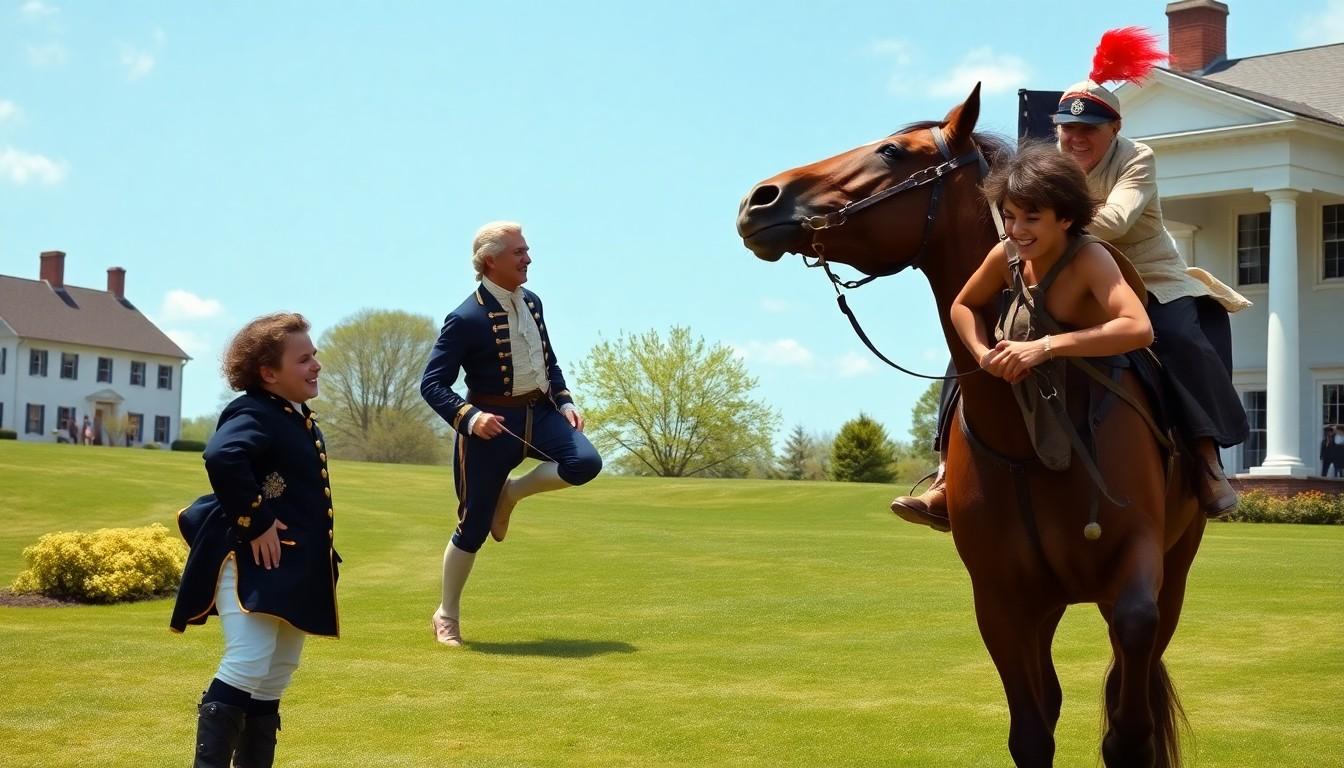Looking to inspire your team with a little humor? Leadership puns might be the perfect way to break the ice and motivate your crew. We’ve compiled the funniest, most captivating wordplay that’ll have your team members grinning while still respecting your authority.
Great leaders know that a well-timed joke can transform workplace culture and build connections. Whether you’re preparing for a presentation, crafting an email, or simply want to lighten the mood in your next meeting, these leadership puns will help you lead with laughter. From “taking the reins” to being “ahead of the curve,” these clever phrases combine wisdom with wit in ways that’ll make your leadership style unforgettable.
10 Leadership Puns That Will Command Attention
- You’re quite the “visionary” leader – Everyone can see you’re doing a great job! Perfect for recognizing someone who consistently demonstrates foresight and clear direction in their leadership approach.
- I’d follow your “lead” anywhere – Your guidance is truly valuable! Use this pun when acknowledging someone who consistently sets a positive example for their team members.
- You really know how to “chair” a meeting – Your facilitation skills are unmatched! This works wonderfully when complimenting someone who effectively manages group discussions.
- That was a real “power” move – Your strategic thinking is impressive! Great for recognizing bold leadership decisions that yield positive results.
- You’re “boss-ing” it today – Keep up the excellent work! This lighthearted compliment works well for acknowledging daily accomplishments.
- Your leadership skills are “suite” – You’re really at the executive level! Perfect for recognizing polished leadership abilities in formal settings.
- You’ve really “taken charge” of this project – The results speak for themselves! Use this when acknowledging someone who has embraced ownership of initiatives.
- Your management style has great “authority” – People naturally respect your approach! This pun works well when recognizing a leader’s earned credibility.
- You’re a natural “head-quarters” – The team thrives under your guidance! Perfect for recognizing someone who creates a supportive environment for their team.
- Your leadership deserves a “standing ovation” – We’re all impressed by your performance! Use this to acknowledge exceptional leadership that has significantly impacted the organization.
Why Humor Is Essential In Effective Leadership

Leadership with a side of laughter isn’t just enjoyable—it’s effective. Research shows that leaders who use humor effectively are perceived as 27% more motivating by their teams, significantly improving their leadership impact. But, wielding humor requires finesse and several key competencies to truly leverage its benefits in the workplace.
Breaking The Ice With Laughter
Authentic humor serves as a powerful icebreaker in tense or formal business settings. Leaders who naturally incorporate appropriate jokes create more relaxed environments where team members feel comfortable sharing ideas. Studies indicate that when humor flows genuinely rather than appearing calculated, it resonates more effectively with employees. Conversely, forced or excessive attempts at humor, particularly from authority figures, can backfire dramatically. Teams often experience emotional labor when required to respond positively to a leader’s awkward humor attempts, eventually decreasing overall job satisfaction and engagement.
Building Team Connection Through Humor
Well-executed humor fosters deeper team connections and strengthens workplace relationships. The success of humor in building these bonds depends largely on a leader’s ability to read the room and gauge team members’ reactions. Skillful humorous moments create positive work environments where collaboration thrives and team cohesion increases naturally. Leaders must balance their comedic timing with consideration for their audience, ensuring jokes land appropriately without alienating team members. Research demonstrates that contextually aware humor builds trust, while poor attempts can create divisions and unnecessary emotional burdens for employees who feel obligated to respond positively even though discomfort.
“Lead” The Way With These Wordplay Classics

Metal-Based Leadership Puns
When it comes to leadership humor, metal-based puns can really help you forge stronger connections with your team. Leaders who appreciate a good play on words know that incorporating these material-focused jokes can add some shine to workplace communication. Why did the leader become a locksmith? To unlock the potential of their team! This clever wordplay demonstrates how leadership is about opening doors of opportunity for others. Some managers turn workplace challenges into opportunities for humor, like handling a leaky faucet by transforming it into a drip of puns. These metal-related quips aren’t just amusing—they reflect a leader’s ability to find creative answers while maintaining a positive atmosphere.
Directional Leadership Jokes
Handling the path of leadership often provides perfect material for directional humor that resonates with teams. Leaders who arrive late to work might joke they were simply trying to find the shortcuts to success, using self-deprecating humor to acknowledge human imperfections. Bosses bringing maps to the office claim they’re preparing to find their way out of a crisis, cleverly acknowledging the navigational challenges of leadership. Some managers bring ladders to team meetings, explaining they’re ready to reach a new level—combining physical direction with career advancement metaphors. The comparison between a boss and a traffic light—having control but lacking clear intentions—highlights how directional humor can gently poke fun at leadership dynamics while fostering a more relaxed workplace environment. These navigational jokes serve as excellent icebreakers during challenging periods when teams need guidance through uncertain territory.
Management Puns That “Boss” The Comedy Scene

Looking to add some humor to your management style? These puns will help you connect with your team while maintaining your leadership presence, all with perfect comedic timing.
Corporate Ladder Wordplay
Climbing the corporate ladder becomes much more enjoyable with a few well-placed puns. “Our company structure is very step-by-step, just like our corporate ladder” can lighten discussions about career advancement. Leaders who incorporate such wordplay create a more approachable atmosphere in hierarchical settings. Research shows that authentic humor from leadership positions builds trust when used appropriately, especially when discussing organizational structure. Executives find that saying “I’m at the top of my organizational chart—and my pun game” demonstrates confidence while fostering connection. Remember that according to leadership studies, humor works best when it comes from a genuine place rather than being calculated, particularly when addressing power dynamics within an organization.
Meeting-Related Humor
Meetings become memorable when sprinkled with appropriate humor that acknowledges their challenges. “This meeting could have been an email, but then we’d miss my amazing puns” acknowledges common workplace frustrations while diffusing tension. Effective leaders understand that meeting-related jokes require reading the room first. Studies indicate that leaders need exact competencies to use humor effectively, including contextual awareness and skillful delivery, particularly in meeting settings where power dynamics are evident. Managers who joke “I called this meeting because my calendar was feeling lonely” can create rapport, but only when trust already exists between them and their team. Research reveals that when trust in leadership is high, humorous comments during meetings can increase creativity and social cohesion rather than creating emotional labor for employees who feel obligated to laugh.
Team-Building Puns To Inspire Your Staff

Building strong teams requires both effective leadership and the right atmosphere. Humor can be a powerful tool when used authentically and appropriately to foster team cohesion and motivation.
Collaboration Wordplay
Fostering teamwork often requires breaking down barriers, and collaboration wordplay can help create that connection. “Our team doesn’t just work together, we ‘co-labor-ate’ on success” creates an instant reminder of the shared effort behind achievements. Teams that “put their minds together always ‘brain-storm’ up the best answers” acknowledges the collective intelligence of your group. Research shows that when leaders use contextually appropriate humor, employee creativity and engagement increase dramatically. “Let’s ‘join forces’ to tackle this project—we’re stronger when we’re not ‘a-lone'” demonstrates recognition of individual contributions while emphasizing the value of teamwork. Authentic humor around collaboration reinforces trust relationships, particularly when power dynamics exist between leadership and team members.
Motivation-Themed Jokes
Motivation puns can energize your team when delivered with genuine enthusiasm and proper timing. “I believe in your potential so much, I’m ‘charged up’ about our future together” creates an electrical connection between leader and team members. Studies indicate that leaders who use humor effectively are perceived as 27% more motivating than those who don’t. “Our team doesn’t just ‘run’ with ideas—we sprint marathons with them” celebrates both initiative and endurance. Leaders should ensure their humor reflects authentic intention rather than functioning as a calculated tool, as forced humor can create emotional labor for employees. “You’ve really ‘stepped up’ to the challenge—your ‘footprint’ on this project is impressive” acknowledges individual contributions while maintaining group cohesion. Reading the context and understanding reactions remain crucial elements when using motivation-themed jokes, as this awareness helps prevent humor from backfiring in professional settings.
“Executive” Decision: Puns For Leadership Presentations

Opening Line Icebreakers
Starting your leadership presentation with a well-timed pun can instantly break the ice and engage your audience. These opening lines will help you command attention while showcasing your lighter side:
- “I’m not a bad leader; I just have a lot of pun-derful ideas!” This self-deprecating opener acknowledges your humor while setting a relaxed tone.
- “Why did the leader start a garden? To grow a team of talented individuals!” This metaphorical icebreaker subtly introduces the concept of nurturing talent and growth.
- “Why did the leader become a beekeeper? To create a hive of productivity!” Use this opening line to transition into discussions about team collaboration and efficiency.
Slide Transition Humor
Maintaining audience engagement throughout your presentation requires smooth transitions between topics. These puns will help you shift focus while keeping energy levels high:
Transitioning to a new topic:
- “Time for a pun-derful fix. Let’s move on to the next slide.” This transition acknowledges the humor while redirecting attention.
- “Let’s paint the town with success. Here’s our next topic.” Use this line when shifting to a discussion about achievements or goals.
Addressing challenges:
- “We’ll bounce back like a pun in a comedy club. Here’s how we handle setbacks.” This transition acknowledges difficulties while maintaining optimism.
- “How does a leader handle a messy office? By sweeping away the clutter with a broom of puns. Let’s tidy up this issue.” Perfect for introducing problem-solving strategies.
Encouraging creativity:
- “How does a leader encourage creativity? By painting a canvas of laughter and innovation. Let’s brainstorm some ideas.” This transition naturally leads into ideation sessions.
Handling problems:
- “How does a leader handle a leaky faucet? By turning it into a drip of pun-der. Let’s fix this issue.” Use this when addressing exact challenges that need resolution.
- “How does a leader handle a power outage? By illuminating the workplace with the light of puns. Let’s brighten up this situation.” This metaphor works well when discussing how to overcome obstacles.
How To Use Leadership Puns Appropriately

Leadership puns can be powerful tools when used correctly, but they require careful consideration to avoid potential pitfalls. Research shows that humor’s effectiveness depends largely on several key factors that every leader should consider.
Reading The Room
Successful humor implementation starts with accurately assessing the environment. Studies published in PMC identify “reading the context” as a fundamental element for leaders using humor effectively in the workplace. Leaders must develop awareness of social and cultural workplace nuances to prevent their puns from being misinterpreted or causing offense. Timing matters significantly—a joke that works during a casual team lunch might fall flat during a serious performance review. Pay attention to the current emotional climate, as humor landing poorly during stressful situations can damage trust rather than build it.
Knowing Your Audience
Understanding who you’re speaking to dramatically impacts how your leadership puns will be received. Research specifically highlights “understanding reactions” as a critical component of successful workplace humor. Different team members respond uniquely to humor based on their personalities, cultural backgrounds, and relationships with you. New team members might not understand inside jokes that veteran employees appreciate. Cultural differences can affect how certain puns are interpreted across diverse teams. Consider each individual’s communication style before deploying humor, ensuring your puns connect rather than alienate team members.
Authenticity and Power Dynamics
Leadership puns work best when they come naturally rather than feeling forced or calculated. Research featured in Fast Company reveals that humor from leaders can create emotional labor for employees when it seems inauthentic or when important power imbalances exist. Your humor should reflect your genuine personality instead of mimicking someone else’s style. Employees can typically detect when humor feels forced, which undermines its effectiveness and your credibility. Remember that power differences amplify the impact of your words—what you consider a light joke might feel like an obligation to laugh for your team members.
Judgment and Delivery
Making wise decisions about when and how to use puns requires careful consideration. Research emphasizes “judgment and decision” alongside “skillful delivery” as essential elements for leadership humor. Practicing your timing ensures puns land effectively without seeming awkward or interrupting important conversations. Delivery matters just as much as content—even the best pun can fall flat with poor execution. Stay attentive to audience reactions, adjusting your approach based on how your humor is received. Consider the medium carefully, as puns that work well in person might lose their impact in written communications like emails.
Avoiding Excessive Humor
Too much of a good thing applies strongly to leadership puns. Studies highlighted in Harvard Business Review found that excessive humor from leaders, particularly in hierarchical settings, decreases job satisfaction and increases emotional exhaustion among employees. Balance humor with seriousness to maintain professional credibility. Limit puns to appropriate situations rather than making them a constant feature of all interactions. Focus on quality over quantity—a few well-placed, thoughtful puns create more positive impact than constant joking. Monitor team reactions carefully to ensure your humor enhances rather than detracts from workplace satisfaction.
When Leadership Humor Falls Flat: Recovery Tactics

Read the Context Carefully
Reading the room correctly is essential when using humor in leadership positions. Leaders must assess the current situation, audience receptiveness, and organizational culture before attempting jokes or puns. Research shows that effective humor in leadership requires carefully evaluating the context to ensure appropriateness. When your joke falls flat, acknowledge the mismatch between your humor and the situation with a simple statement like, “Tough crowd today—let’s get back to our agenda,” which demonstrates your awareness of the context without dwelling on the awkward moment.
Rebuild Trust Through Transparency
Trust serves as a critical foundation for effective leadership humor. Studies indicate that when trust in leadership is high, humor is more likely to be well received and can enhance creativity and employee inclusion. After a humor misstep, focus on rebuilding trust through transparent communication. Admit when your joke didn’t land with something like, “That clearly wasn’t as funny as it sounded in my head—appreciate your patience with me.” This honesty reinforces your authenticity and helps repair any potential damage to team dynamics.
Employ Self-Deprecating Recovery
Self-deprecating humor provides an excellent recovery tool when leadership jokes fall flat. Research shows this approach can effectively restore social balance after an awkward humor attempt. Rather than ignoring the silence after a failed joke, acknowledge it with a light comment about your own comedic abilities. For example, “I’ll keep my day job—clearly comedy isn’t my strength,” redirects attention from the failed joke to your willingness to laugh at yourself, which can actually strengthen your connection with team members.
Recognize Emotional Reactions
Leaders need emotional intelligence to recognize when their humor creates negative outcomes. Research has found that inappropriate humor can increase emotional exhaustion and surface acting among employees. Pay attention to nonverbal cues such as forced smiles, uncomfortable shifting, or averted gazes after a joke falls flat. Adjust your approach immediately if you notice these signs by shifting to a more straightforward communication style and avoiding further humor attempts in that particular meeting or context.
Refine Your Humor Strategy
Successful humor requires developing exact skills that improve your effectiveness over time. Leaders should focus on intention, judgment, and delivery when using humor. After a failed attempt, take time to analyze what went wrong by considering whether the timing was off, the content was inappropriate, or the delivery needed improvement. Use each misstep as a learning opportunity to refine your approach. For instance, asking a trusted colleague for feedback on why a particular joke didn’t land can provide valuable insights for future interactions.
Pivot to Genuine Connection
When humor fails, pivot quickly to genuine connection rather than attempting more jokes. Research indicates that forced humor can lead to decreased job satisfaction and create divisions within teams. After a joke falls flat, transition to authentic engagement by asking thoughtful questions or expressing sincere appreciation for the team’s efforts. This shift demonstrates emotional intelligence and reinforces that your primary goal is meaningful communication, not simply entertainment. A genuine statement like “What I really want to express is how much I value your contributions” can effectively reset the tone.
Historical Leaders Who Used Humor Effectively

George Washington
America’s first president wasn’t just known for his leadership during the Revolutionary War—he also had a surprising sense of humor behind that serious facade. Washington once laughed so hard that tears streamed down his face when watching a young soldier get thrown over the head of a fiery horse he had purchased. His ability to appreciate witty banter was evident when he good-naturedly took a joke from Henry Lee about his frugality in purchasing carriage horses, even involving Mrs. Washington’s parrot in the laughter.
Abraham Lincoln
Lincoln mastered the art of using humor as a leadership tool, frequently employing funny stories to diffuse tense situations and connect with people. One famous example demonstrates his quick wit when he “dunked on” a particularly talkative opponent during a speech. Rather than responding with anger or dismissal, Lincoln used humor to effectively silence the man without causing offense or creating animosity.
Martin Luther
The Protestant reformer Martin Luther wielded his sharp wit as effectively as his theological arguments. His writings often contained humorous elements that made his revolutionary ideas more accessible to common people. Luther’s personal roasts were typically light-hearted rather than malicious, showing how humor can soften potentially controversial messages while maintaining their impact.
Eleanor Roosevelt
As First Lady, Eleanor Roosevelt employed wit and humor during official visits and public interactions to great effect. Her use of well-timed humor made her more relatable and approachable to the American public, helping her connect with people across social divides. This accessibility enhanced her effectiveness as a public figure and humanitarian.
Modern Presidential Humor
Recent presidents have also showcased effective leadership humor. In 2014, former Presidents Bill Clinton and George W. Bush launched the Presidential Leadership Scholars program with an unexpected comedy routine that included jokes about selfies and Clinton’s phone ringing during the presentation. Their humorous banter highlighted their friendship even though political differences, demonstrating how humor can bridge partisan divides.
Barack Obama occasionally revealed his more casual side through humor, as seen when his off-the-record comment calling Kanye West a “jackass” went viral after West’s notorious VMA interruption. This unguarded moment, though not initially intended for public consumption, showed a relatable aspect of Obama’s personality that many Americans connected with.
These historical examples prove that effective leaders throughout history have used humor to humanize themselves, build rapport with constituents, and navigate challenging situations with grace. Their ability to laugh—and make others laugh—created stronger connections and enhanced their overall effectiveness as leaders.
Crafting Your Own Leadership Puns: A Step-By-Step Guide

Creating your own leadership puns doesn’t require a comedy degree—just a bit of wordplay and understanding of leadership concepts. We’ve developed this comprehensive guide to help you create puns that will lighten the workplace mood and strengthen your team connections.
Step 1: Choose a Leadership Theme
Leadership encompasses many concepts that serve as excellent foundations for puns. Select a exact aspect you want to address such as:
- Teamwork and collaboration
- Decision making processes
- Problem solving approaches
- Motivation and inspiration
- Strategic planning
- Change management
Focusing on a particular theme helps direct your creativity toward more relevant and impactful puns that resonate with your leadership context.
Step 2: Brainstorm Related Words
Once you’ve selected your theme, generate a list of words and phrases commonly associated with it. For example:
- Teamwork: collaboration, unity, synergy, together, team players
- Decision Making: choices, options, paths, direction, crossroads
- Motivation: inspire, drive, energy, momentum, spark
This vocabulary bank becomes the raw material for your wordplay, giving you multiple options to transform into humorous leadership expressions.
Step 3: Create Wordplay
Transform your leadership terminology into clever puns by playing with similar-sounding words or multiple meanings. Some examples include:
- “Why did the leader start a band? To create a team that’s in harmony!”
- “How does a leader handle a storm? By weathering it with a storm of answers!”
- “Why did the transformational leader become a chef? To whip up a recipe for change!”
Effective puns often leverage the dual meanings of words or phrases related to leadership concepts, creating unexpected and humorous connections.
Step 4: Tailor to Your Leadership Style
Personalize your puns to reflect your unique leadership approach. Whether you embrace a democratic, autocratic, or transformational style, your wordplay should authentically represent your leadership personality.
Democratic leaders might prefer: “My door is always open—just like my suggestion box is full of ‘open-ions’!”
Transformational leaders could use: “I don’t just lead change—I ‘trans-form’ it into opportunity!”
Step 5: Use in Appropriate Contexts
Strategic placement of your leadership puns maximizes their effectiveness. Consider using them in:
- Opening lines of team meetings to set a positive tone
- Email communications to lighten a heavy message
- Team building activities to foster connection
- Difficult conversations to reduce tension
- Leadership presentations to engage your audience
Starting a meeting with “Let’s put our heads together—that’s how we get ‘ahead’ of the competition!” can immediately create a more receptive and relaxed atmosphere.
Remember that timing is everything—well-placed puns can transform a tense situation into a productive one, while poorly timed jokes might fall flat. By following these steps and practicing your delivery, you’ll develop a repertoire of leadership puns that enhance your communication style and strengthen your connection with your team.
Conclusion: The Lasting Impact Of Humor In Leadership
Leadership puns do more than just get a laugh—they transform workplace dynamics and strengthen team bonds. When used with authenticity and awareness these witty wordplays become powerful tools that humanize leaders and create memorable moments.
We’ve seen how historically important figures and modern leaders alike have used humor to navigate challenges and build connections. The research confirms what we intuitively know: humor makes leaders more approachable and teams more cohesive.
Remember that effective leadership humor requires reading the room timing and genuine delivery. By incorporating these puns strategically you’ll not only lighten the mood but also demonstrate emotional intelligence and enhance your leadership presence. So go ahead—lead with laughter and watch your team thrive.
Frequently Asked Questions
Why are leadership puns important in the workplace?
Leadership puns combine humor with wisdom, helping leaders inspire and motivate teams. Research shows leaders who use humor are perceived as 27% more motivating. Well-timed jokes can serve as icebreakers in tense situations, create a relaxed environment for sharing ideas, foster deeper team connections, and make a leader’s style more memorable. Humor, when used authentically, builds trust and strengthens workplace relationships.
How can I use leadership puns effectively?
Use leadership puns strategically in presentations, emails, and meetings. Read the room and know your audience before delivering humor. Ensure your jokes are authentic and contextually appropriate. Balance humor with professionalism, and consider timing and delivery. Leadership puns work best when they acknowledge real situations or qualities while adding a lighthearted touch. Never force humor, as it can backfire and decrease job satisfaction.
What are some examples of effective leadership puns?
Examples include: “You’re quite the ‘visionary’ leader” (acknowledging foresight), “I’d follow your ‘lead’ anywhere” (highlighting guidance), “You really know how to ‘chair’ a meeting” (celebrating facilitation skills), and “Our team doesn’t just work together, we ‘co-labor-ate’ on success” (emphasizing collaboration). Metal-based puns like becoming a “locksmith to unlock potential” and directional jokes about “navigating challenges” are also effective.
Can leadership puns backfire?
Yes. Forced or contextually inappropriate humor can decrease job satisfaction and create emotional burdens for employees. Poor attempts at humor can create divisions rather than connections. When humor falls flat, it can damage trust and team dynamics. Leaders should be aware of their team’s reactions and cultural sensitivities, and have established trust before using more personal or complex humor.
How do I recover when my leadership humor falls flat?
Acknowledge when a joke doesn’t land instead of pushing forward. Rebuild trust through transparency and authenticity. Consider using self-deprecating humor to ease tension. Recognize emotional reactions and pivot to genuine connection after a failed joke. Demonstrate emotional intelligence by listening to feedback and adjusting your approach. Remember that successful humor requires ongoing refinement and awareness of your audience.
Did historical leaders use humor effectively?
Yes, many renowned leaders leveraged humor successfully. George Washington used wit to build rapport, Abraham Lincoln defused tensions with humor, Martin Luther employed it against opposition, and Eleanor Roosevelt used self-deprecating jokes to connect with people. Modern examples include Bill Clinton and Barack Obama, who used humor to appear more relatable and bridge political divides.
How can I craft my own leadership puns?
Choose a leadership theme (teamwork, vision, etc.). Brainstorm related words and look for opportunities for wordplay or double meanings. Create puns that align with your personal leadership style and the context. Test your puns with trusted colleagues before using them more broadly. Strategically place your puns in presentations, emails, or meetings where they’ll have maximum impact while maintaining professionalism.
When should I avoid using leadership puns?
Avoid humor during serious discussions about performance issues, layoffs, or sensitive company matters. Don’t use puns that could be perceived as mocking, sarcastic, or that target specific individuals or groups. Be cautious with humor in cross-cultural settings where meanings might get lost in translation. If you haven’t established trust with your team yet, focus on building relationships before incorporating humor.







